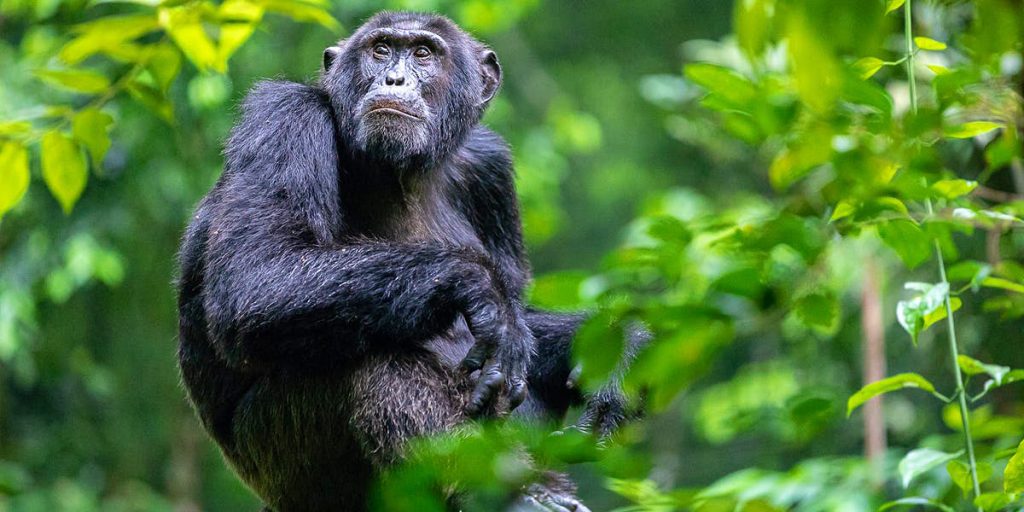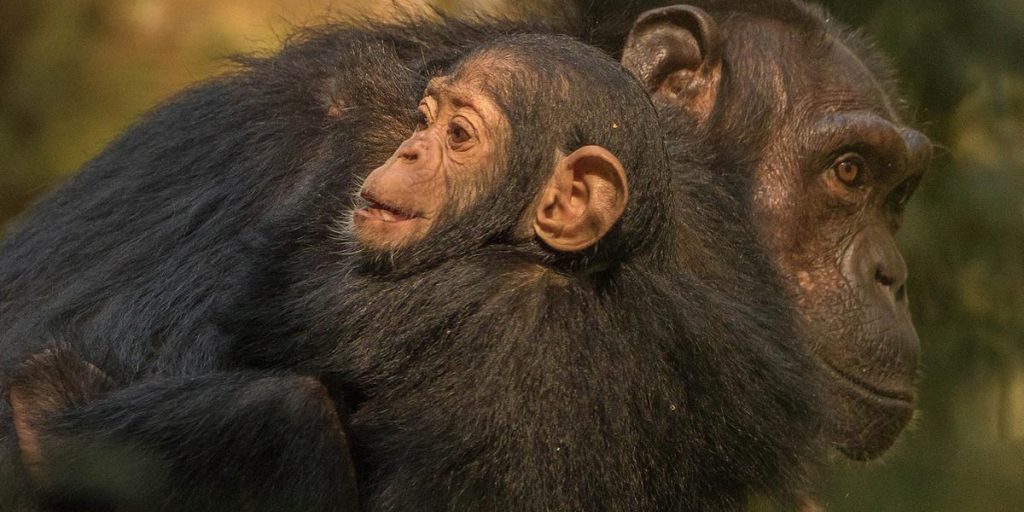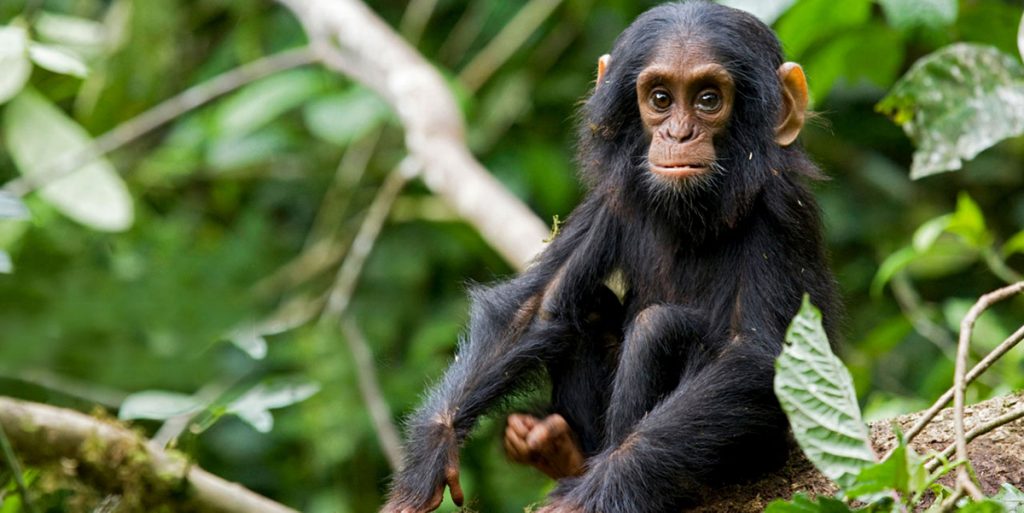Chimpanzee Facts, Lifespan, Size, Strength, Habitat & Diet
Chimpanzee Facts, Lifespan, Size, Strength, Habitat & Diet
At the first encounter, the sound you will hear is probably laughter — soft, rhythmic, and unsettlingly familiar. Not human. Not animal. Something in between.
You look up.
A blur of limbs swings across the canopy. One chimp lands with a thud just meters ahead, grinning like he’s in on some joke you’ll never get. Another one sits above, legs dangling, picking his teeth with a twig. He stares right at you.
There it is — that feeling.
Not like you’re watching a wild animal. More like you’re looking into a mirror.
In Uganda’s Kibale Forest, nothing prepares you for how… human they feel. Chimpanzees don’t just climb trees — they shake the branches. They don’t just move in groups — they gossip, argue, make up, and fall silent together.
During a chimp trek, you’re not just trekking through the jungle. You’re navigating a community.
The ranger whispers, “That’s the alpha,” as a large male strut by with all the confidence of a nightclub bouncer. Another one bangs on a tree trunk just to show off. Babies tumble around like toddlers with too much sugar.
This isn’t just a performance because you are around. It’s daily life of these intelligent apes.
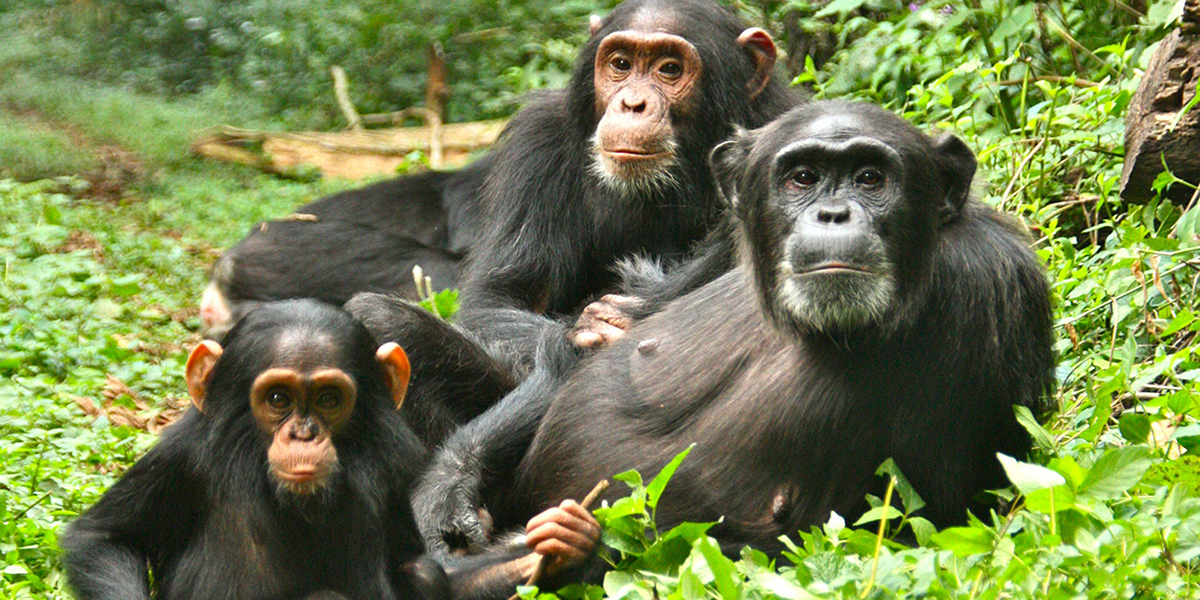
A Chimpanzee Family in the Wild
Chimpanzee Classification: Closer Than You Think
Here’s where they fall in the scientific family tree — and why it matters more than it seems:
Kingdom: Animalia
Phylum: Chordata
Class: Mammalia
Order: Primates
Family: Hominidae
Genus: Pan
Species: Pan troglodytes (Common Chimpanzee)
That word — Hominidae — means we share this family. Not just distant relatives. As humans, we share over 98% of the same DNA with chimps. So when a chimp throws a tantrum, shares food, or plays peek-a-boo with your camera lens, it hits you…
Don’t be surprised, cos you’ve seen that before. In yourself.
Recommended Safaris
5-Day Kahuzi Biega Congo Gorilla Trekking & Chimp Safari in Rwanda
$ 2500
per personChimpanzee’s Habitat
In Uganda, their stronghold is Kibale Forest National Park, where over 1,500 individuals swing, hoot, and screech through a dense jungle layered in sound. You’ll find them in Budongo, Kalinzu, Kyambura Gorge, and sometimes, the tangled edges of Queen Elizabeth National Park.
They live where food grows and trees reach high — in forests with light and shadow, silence and chaos. Their territory isn’t static. It’s dynamic, ever-changing, negotiated through vocal calls and chest beats.
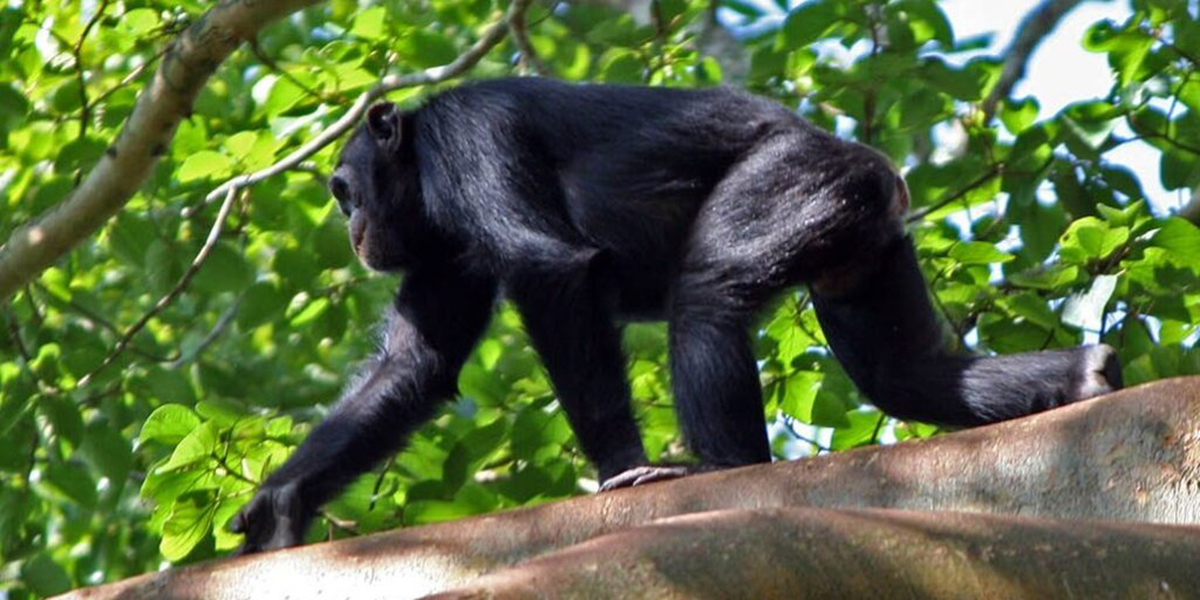
Chimpanzee in Kibale Forest National Park
Chimpanzee’s Size: Smaller Than Us, Louder Than Life
A chimpanzee doesn’t need to be tall to feel enormous.
Standing upright, males average 1.2 meters and weigh around 40 to 60 kilograms — but you won’t be thinking about numbers when one swings past your head with the energy of a fired-up toddler.
Their real size is in their personality. Bold. Curious. Unfiltered. One look from them and you know exactly what they’re thinking — because it’s probably what you’re thinking.
Chimp Diet: Brain Food in the Bush
Chimp’s major diet is fruits, seeds, flowers, leaves, and bark, but they also eat insects and small animals. Yes — they hunt. In groups. With coordination. Sometimes even passing meat around like a family dinner.
When necessary, you’ll see the excitement of a group hunting a red colobus monkey. It’s shocking. And raw. But it’s real. They also do eat meat sometimes.
Chimpanzee Intelligence: Minds in the Trees
You’re watching a chimp crack nuts with a stone. He picks one, tests the weight, lines it up perfectly, then slams down with precision.
Not a trick. Not luck.
It’s problem-solving skill that chimps are born with— one of many signs of high intelligence. Chimps use tools. They teach their young. They hold grudges. They even recognize themselves in mirrors — something most animals can’t do.
In Kibale and other chimp trekking parks, you may witness them digging for termites with sticks, making sponges from chewed leaves to drink water, or planning coordinated hunts. Some researchers believe their mental development mirrors that of a 4-year-old human child — just wilder and far more agile.
What’s shocking isn’t that they can be thoughtful, deliberate and emotional.
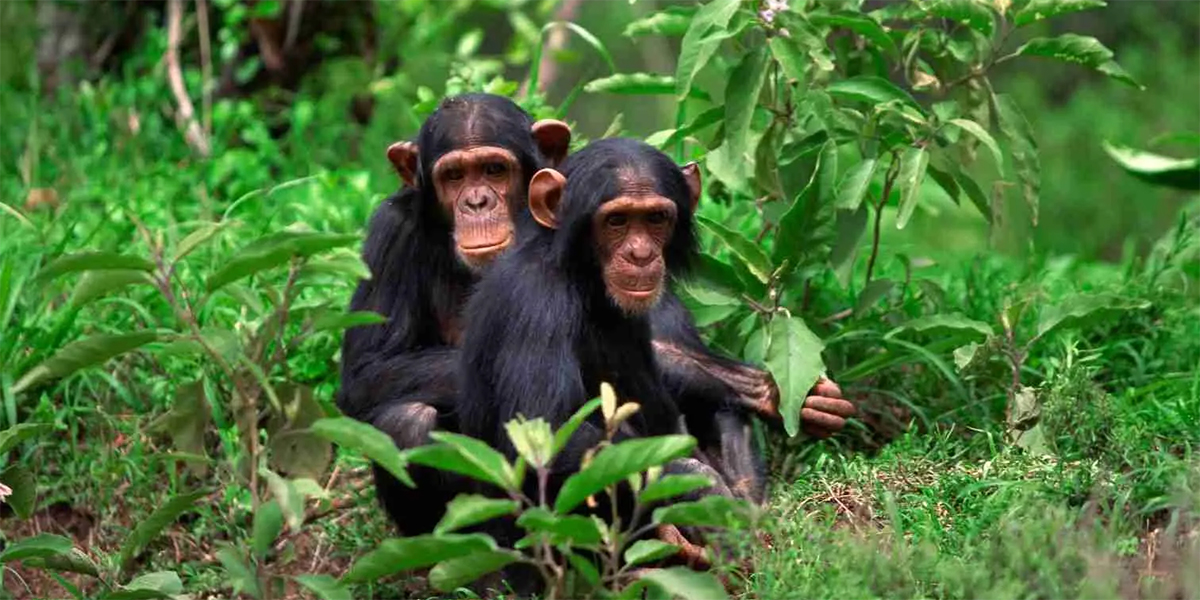
Chimpanzees in Semuliki National Park
Chimp Strength: All Muscle, No Fat
Don’t be fooled by their playful grins.
A full-grown chimp is up to 5 times stronger than a human of the same weight. That’s pure, dense muscle built for climbing, swinging, and occasionally throwing tantrums that shake the forest floor.
One hand on a branch, and they’re airborne. One kick, and they vanish into the trees. Their bodies are designed for movement — fast, fearless, and fluid.
Reproduction: Raised by the Whole Forest
Chimpanzees don’t mate for life. But they do raise life together.
A female gives birth once every 5 to 6 years, after an 8-month pregnancy. Newborns cling to their mothers for months, sometimes years. But here’s the thing — parenting isn’t just for moms. Older siblings help. Aunties help. Even curious young males hang around to babysit.
In chimp society, childhood is sacred. Long. Slow. Filled with play, risk, imitation, and learning. Just like ours.
They Feel. They Think. They Remember.
You watch a chimp pick up a rock. He weighs it. Turns it. Then uses it to crack a nut open on a root. His baby watches, mimicking the motion with a stick.
You see one hold a hand out for grooming — not just hygiene, but trust. You hear one scream in grief when another dies – that’s how emotional chimpanzees are.
During chimpanzee trek, you realize it’s not a sighting anymore. It’s your reality. You realize you’re not just seeing animals. You’re seeing ourselves, uncaged.
Baby Chimpanzees on a Tree Branch
Why Trekking Them Feels So Personal
Chimpanzee trekking isn’t a checklist activity. It’s emotional encounter with the other undiscovered part of us. It’s a meeting with a wild, related part of you.
The trail is slippery, the pace unpredictable, the terrain demanding. But the reward? It’s like meeting your ancestors, your cousins, your kids — all rolled into one.
In places like Kibale, Friendly Gorillas offers ethical, community-driven treks that don’t just observe — they respect. Your presence supports conservation, research, and the people who live with these intelligent beings every day.
Chimpanzee Gallery
Chimpanzee FAQs
What is the best place to see chimpanzees in Uganda?
In Uganda, it doesn’t go without mentioning that Kibale Forest National park is your very best chimp destination, however, you may as well see them in Murchison Falls’ Budongo Forest, Kalinzu Forest, Kyambura Gorge, and Semuliki.
How many chimpanzees are left in Uganda?
Total chimp population in Uganda is approximately 5,000 induvials, with over 1,500 of them found in Kibale Forest National park while the other remaining ones are found in Budongo, Kalinzu, Semuliki and Kyambura Gorge.
Is chimp trekking safe?
Yes, chimpanzee trekking is safe. In fact, it is considered relatively easier than gorilla trekking. During the encounter, you are briefed about the do’s and don’ts before being guided by well trained and armed rangers to the thick forest in search of them.
How close can I get to them?
You’re expected to keep a 7-meter distance, though chimps may come closer. Always follow the guide’s rules to remain safe from the attack.
What is the best time to go chimp trekking?
To get the very best of Chimpanzees trekking, you want to pay them a visit during the dry season any time between December and February. Between July and August are also perfect because during this time, the trails are less muddy, and chimps are easier to track and locate.
How strong is a chimpanzee?
Size does lie here. Chimpanzees are stronger than you may think. In fact, a single chimpanzee is 4 to 5 times stronger than a human of the same weight. You may see them small, but do not try to underestimated them.
How long does a chimp trek last?
Treks usually take 2 to 4 hours, including the hike and 1 hour of viewing.
How much does a permit cost?
As of 2025, a chimpanzee trekking permit cost depend on the park you are trekking from. In Kibale, a single chimp permit costs $250 per person, while it costs USD 100 in Kyambura Gorge.
Can I combine chimp and gorilla trekking in Uganda?
Absolutely. Just like many other past travelers, combining Kibale’s chimpanzees with Bwindi’s gorillas will give you the ultimate primate experience.
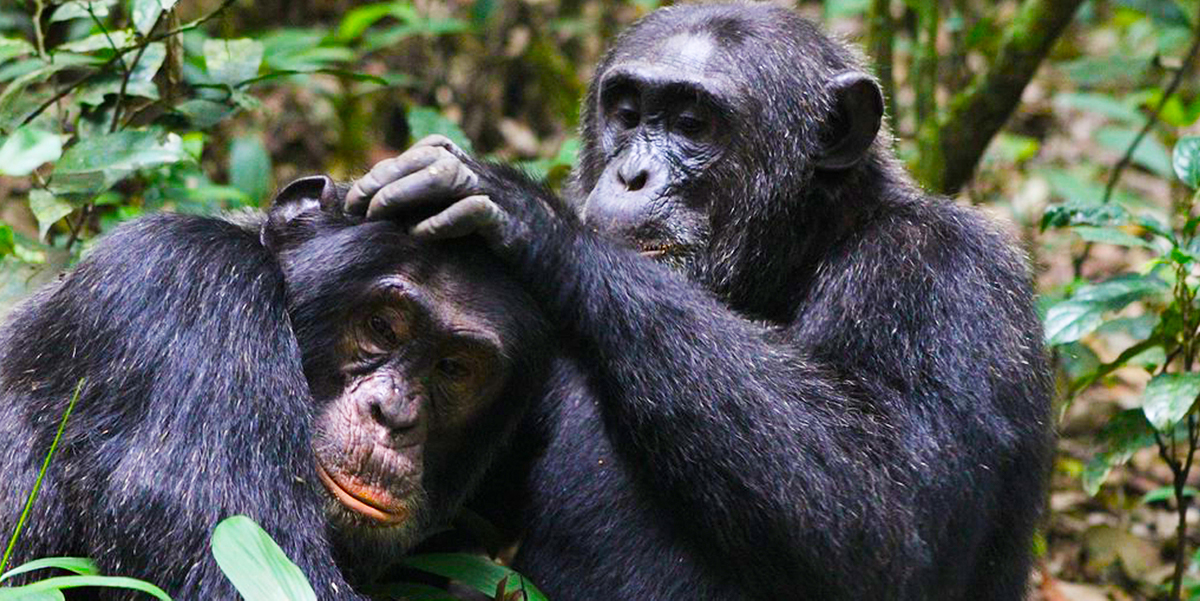
Chimpanzees Playing in the Wild
Recommended Safaris
8 Days Murchison Falls, Gorilla, Chimpanzee & Queen Elizabeth Safari
$ 1790
per personSo… What Will You Think When You See Them Think?
You’ve probably seen a chimp on TV. Maybe in a zoo. Maybe in a meme.
But nothing — absolutely nothing — compares to the moment one looks at you, squints slightly, and seems to wonder who you are.
And in that moment, the forest disappears. The distance between species fades. And you’re just two thinking, breathing beings… seeing each other for the very first time.
Would you like to feel that?
Don’t wait,
book this adventure safari today
Low season
Oct, Nov, Mar, Apr, may
Peak season
Jun, July, Aug, Sept, Dec

Got any questions
about traveling to Uganda?
Get in touch.





